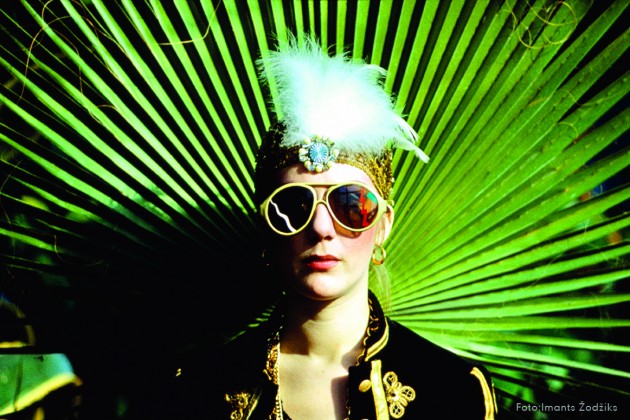
Photo: Imants Žodžiks. 1987
“Currently we are interested in eye dance, which is danced by the world to the rhythm of seconds, minutes, hours, days and nights, phases of the moon, rising and falling of the tides, seasons and solstices.
“Eye dance” – it is an improvised performance for many eyes.
For all eyes – The Restoration of Unprecedented Feelings – hence nothing new, and yet a discovery for everyone.
We believe it is important to answer the question – what do I want, instead of – what do I lack. We do not want to teach you something that you lack.
We only point at the approximate:
by breathing,
by dancing the eye dance,
by waving a tree branch at dawn,
while walking to Bolderāja.”
(NSRD, 1987)
The first NSRD performance of Dr. Enesera Binokulāro deju kursi (Dr. Eneser’s Binocular Dance Classes) was at the Youth Press Festival in Mežaparks Open Air Stage in 1986. In 1987 the performance was filmed inside the Palm House of the Botanical Garden in Salaspils where at the time Juris Boiko, the author of the binocular dance idea and theory, worked as an artist-decorative designer. Dr. Eneser, which was the nickname of Juris Boiko, is an imaginary character, eye dance teacher, whose name originates from the phonetic abbreviation of NSRD. “Dr. Eneser represents the latest – postmodern trend of the eye dance and presents this dance as an ordered world view, that is subjected to a certain rhythm and positions. It is a dream about a new level of human interaction. Possibly without touching. Only by sensing the gentle flutter of partner’s eyelashes. Tête-à-tête. In windless conditions.” (From Juris Boiko’s video work).
Dr. Eneser’s binocular dance classes developed in conjunction with the Approximate art idea. After the Botanical Garden’s performance, the binocular dance classes were presented again during the Art Days as part of the first Approximate art exhibition held at the planetarium (now The Nativity of Christ Cathedral). The dance expressed an enticement of approaching a contemplative rhythm of life, merging with the world through its softly focussed centre, through the diffused borders of the approximate. During the performance this ritual was perfected to an artistic practice, involving experts from both the Video centre and the University of Latvia computing laboratory. Special costumes and accessories had been designed for the performance - architects Imants Žodžiks and Aigars Sparāns created several sets of unusual sunglasses for the beginners of binocular dance to stop them from losing balance during the first minutes of the dance: “The Last Stop of Trolleybus”, “Lightening and Thunder”, “Agaves with the Red Sea in the background” and “Glasses with a horizon” (the latter were intended for those who had “torn themselves away from this sinful earth but would have quite liked to land back on it, preferably on both legs”, explained Imants Žodžiks).
The reconstruction of the performance Dr. Enesera Binokulāro deju kursi (Dr. Eneser’s Binocular Dance Classes), organised by the LCCA, will commence in the lecture theatre of the Botanical Garden with creative workshops for children and adults from 2pm until 4.30pm. These workshops will incite participants on a quest for unprecedented feelings by mastering the sowing of pumpkin seeds, low-warp, weaving and wreathing, dream catching, as well as the making of sound instruments. Participants are invited to join the performance costume design workshop from 4pm until 6.30pm, which will take place in the Palm House. The binocular dance classes led by Roberts Gobziņš will take place at 5pm, 5.30pm, 6pm and 6.30pm – everyone is welcome to join, no prior knowledge of eye dance is required. The participants of the performance will be wearing items from the ‘Trachycarpus binocularis’ collection designed by artist Gundega Evelone – she explains that ‘the collection was inspired by the most mystical and mysterious symbol from the first performance of binocular dance – the palm leaf from the Trachycarpus genus. In the only video clip of the dance it can be seen appearing from time to time and then indiscernibly fluttering away without ever revealing its true meaning. ‘Trachycarpus binocularis’ costumes are sculptural objects, and a keen observer will recognise the use of military symbols and camouflage although it will be impossible to hide. On this occasion, something that is supposed to merge with the tropical thicket and conceal the jungle partisan will instead dazzle and highlight the binocular dancers against the background of green palm trees.”
The dance classes will conclude with a project game ‘Déjà vu’ showing from 7pm until 8pm, created by the students from the audiovisual performance studio at the Technical Innovation House ‘Annas 2’. The students, led by artsist Linda Konone, have developed their own video projects inspired by the NSRD’s music and video works.
Exhibition Austrumacs-Rietumacs (Easterneye-Westerneye), produced by Māra Žeikare and Diāna Popova, will open a week before the reconstruction of the performance in the in the foyer of the Palm House at the Botanical Garden. It will feature video and photographic material from various performances of Dr. Enesera Binokulāro deju kursi (Dr. Eneser’s Binocular Dance Classes). The exhibition layout has been designed by artists Gundega Evelone and Andris Landaus. It will be open to the public from 21 March until 7 April, daily from 10am until 4.30pm in March and from 9am until 7pm in April.
Visitors can access both, the exhibition and the reconstruction of the performance with the Botanical Garden tickets. Address – Kandavas Street 2.
This event has been organised by the Latvian Centre for Contemporary Art in commemoration of 2015 as the Year of Hardijs Lediņš, programme curators – Solvita Krese and Diāna Popova.
The event is part of the project "This is Tomorrow. Back to Basics: Forms and Actions in the Future" co-funded by the Creative Europe programme of the European Union, Ministry of Culture of the Republic of Latvia, State Culture Capital Foundation, ABLV Charitable Foundation etc.